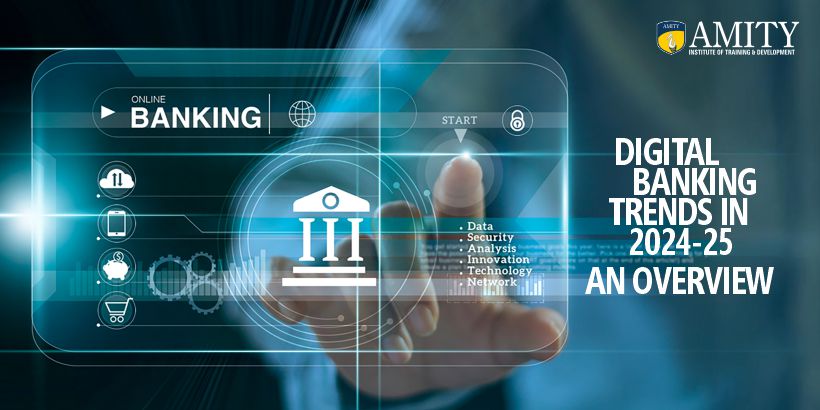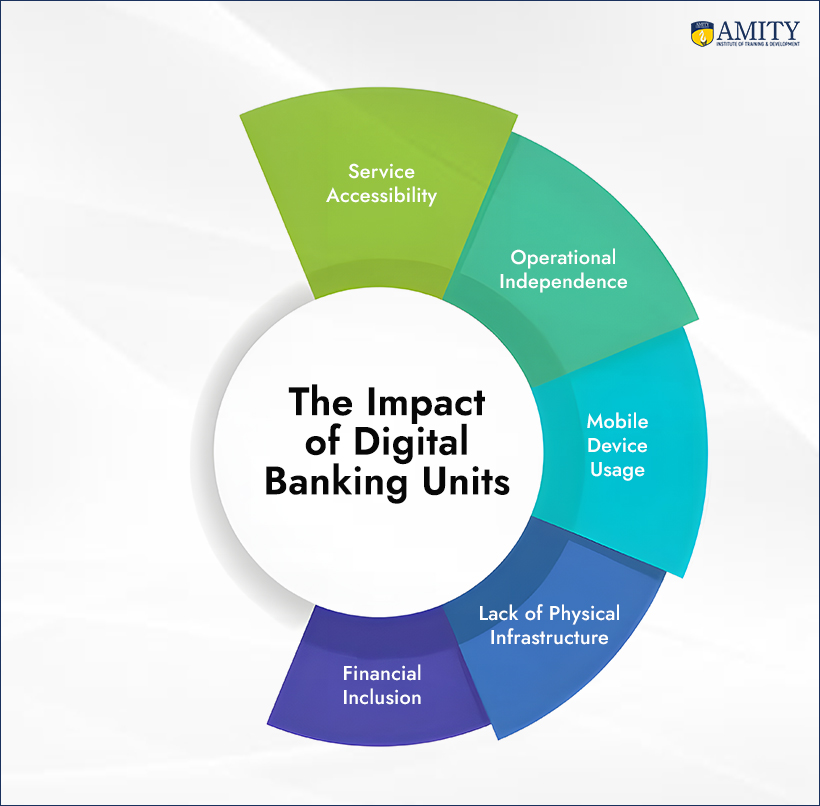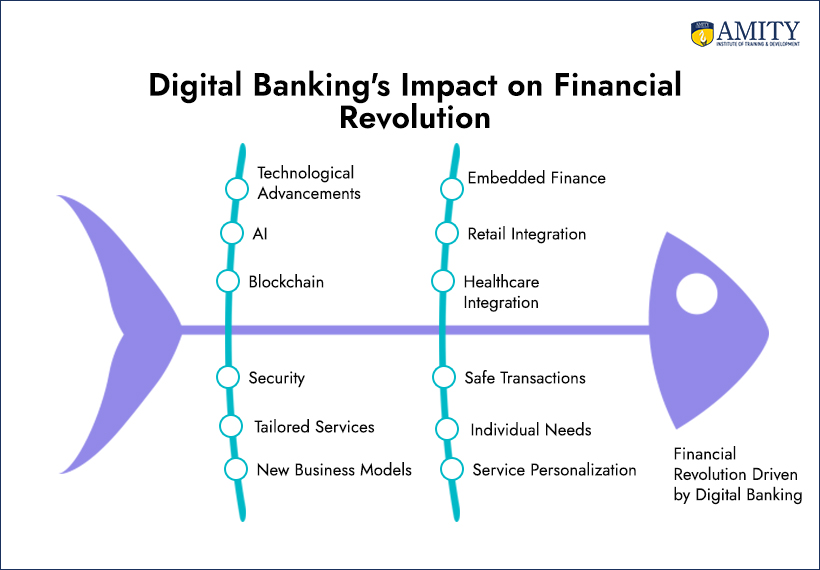Tech-Driven Solutions

In recent years, digital banking has transformed the financial dealings of individuals and companies. With technological advancement, the term (what is digital banking) goes way beyond an online transaction that is now a fully integrated system that changes traditional banking services. Basically (The digital banking meaning), it is the conversion of all the traditional banking operations into a direct source where clients can access their financial dealings using mobile applications, online services, and digital banking products.
Digital banking in India, as in the rest of the world, has brought in types of digital banking services for serving the needs of consumers. This wave has been accompanied by many benefits both to customers and banks. For the former, it has brought faster, more secure, and accessible banking, while it has delivered a reduction in operational cost and expanded reach to the latter.
This acceleration will be further driven into 2024-25. This is where AI, blockchain, and DBUs will have an upper hand shaping the future of service provision in the financial field by providing much-needed enhancement in digital banking, security aspects, and that kind of personal experience as desired by a customer. And this is not just a trend—it’s a switch from an entirely different approach towards the functioning of banks.
Did You Know? Digital banking, much more than just services online, rather it fully transitions over the method the banks work and the mode in which they deliver their services to their clients.
Some of the major digital banking trends 2024-25 are as follows:
Major Digital Banking Trends in 2024-25:
AI and ML are being integrated with digital banks to personalize, predict, and advance fraud detection. Hence, it makes them all the more important as they point towards better financial solutions and effectiveness of customer service.
Blockchain technology is increasingly important to protect financial transactions, reduce fraud, and get transparent in banking operations. Increasingly, smart contract use and a guarantee of cross-border payments are made by digital banks through blockchain.
Open Banking:
Open banking is now a trend all over the world, where more and more customers are in control of their financial information. In this regard, third-party financial service providers will be allowed to access customer data with consent, thereby boosting competition and innovation among financial services.
Biometric Authentication:
The digital banks are utilizing various types of biometric authentication techniques, such as facial recognition and fingerprint scanning to have more solid security and faster log-in processes for the customer.
Embedded Finance
More and more, financial services are integrated into non-financial platforms. Retail, health, and travel companies install financial services directly in their apps and websites to bring financial services to consumers’ doorsteps.
Digital Banking Units (DBUs):
DBUs are gaining momentum in India and other similar markets. They provide full digital banking solutions just for the tech-savvy, the under-served, or residents of remote areas, thus advancing financial inclusion.
CBDCs
The central banks of all nations are studying or testing introducing CBDCs – a digitized and distributed version of fiat currency through electronic means.
Hyper–Personalization:
The banks are giving hyper-personalized services using advanced data analytics, catering to the needs of their customers. With the behavior and preferences of the customers analyzed, the banks can offer personalized product recommendations, loan offers, and investment advice.
Digital Wallets/Contactless Payments
The digital wallets and contactless payments are also experiencing an upswing in 2024-25 due to their faster, more secure, and convenient options for payments. Among the digital wallets include Apple Pay, Google Pay, among others, mobile payment solutions are now used highly.
Cloud-Based Banking Service:
More digital banks are embracing cloud computing lately to enjoy improved storage, processing, and access to data. The advantages of the cloud-based banking platforms to the institution providing banking operations include more flexibility, scalability, and cost-efficiency.
Importance of Digital Banking Security
Digital banking transformation therefore is the promise of safety and sound security measures. The threat of cyberattacks, frauds, and data breaches coupled with increasing use of digital platforms, does point to an area that needs watching and worry. To protect customer information, the banks have been spending on cybersecurity, encryption technologies, and ensuring safe data handling.

Customers today require levels of privacy and data protection. This makes security the most significant dimension of digital banking in 2024-25. As a result, banks are making a thrust in preventing fraud risks and conducting seamless and secure digital transactions by aiming at the reduction of fraud risks and ensuring safe and smooth transactions through the introduction of biometric authentication, multi-factor verification, and blockchain-based security.
Did you know? Digital banks employ real-time fraud detection systems based on AI, which monitor transactions in real time to alert them of dubious activity while protecting customers’ financial data.
The Second Important Innovation is the Digital Banking Units (DBUs)
The Digital banking units are more important innovations and have become fast-paced especially in the emerging markets. DBUs are essentially full-fledged branches that are operationally independent but are fully or partially without any physical infrastructure. These include opening a digital bank account, processing loans, managing deposits, etc.

In countries where most populations live in villages or far-flung areas, such as in India, DBUs hold special significance. There, financial inclusion is leading the way because DBUs bring out the unbanked population closer to formal banking systems. These units allow customers to use mobile devices and enjoy wide-ranging banking services; hence, it makes access both easier and more accessible.
Important Aspects to Discuss in Relevance to Digital Banking
What Is Digital Banking and Why Is It Important?
Digital banking, therefore, is the digitization of all the traditional services that, until recently, could only be accessed at physical bank branches. These include money transfers, account management, payments, and loans. From a point of view of importance, digital banking is crucial in providing quicker, easier, and lower-cost services to customers and giving banks the opportunity to streamline their operations.

Role of Digital Banking in Financial Revolution
The disrupting process in the financial landscape is brought about through new business models, products, and services by this digital revolution that comes from the technological side of banking. This is as the technologies continue to grow such as AI, blockchain, and open banking. It can be achieved that banks offer services that are tailored for specific individuals in a very safe way. Also, with economies continuing to integrate different sectors like retail and healthcare, it also boosts this aspect of embedded finance.

What are the advantages of digital banking?
Benefits of Digital Banking to The Customers:
Digital banking offers numerous benefits. For a customer, it provides ease, round-the-clock access, speedy transactions, and wide-ranging services. For a bank, reduced operational costs for going digital, reaching out to more customers, and making extensive data management easier. In addition, digital banking solutions have furnished improved security features and enhanced fraud prevention mechanisms.
How AITD Can Help?
The world of digital banking is changing rapidly, and organizations must ensure the workforce has adequate proficiency for adaptation to newer technologies and customer demands. Amity Institute of Training and Development (AITD) provides specialized training programs customized specifically to the banking industry to help professionals stay ahead in the digital banking landscape with insights into the latest trends and technologies.
Here is how AITD can help the digital banking professional
Training Solutions in Digital Banking: Acquire sound knowledge about all new products and services of digital banking, cloud-based banking, AI-driven solutions, and mobile banking platforms.
Cybersecurity Training:
Learn the best practices available to secure digital banking platforms, protect customer data, and prevent cyberattacks.
Regulatory Compliance Training:
Be updated with the new requirements and standards relating to digital banking in order for your organization never to violate any law at a national or international level.
Customer-Centric Services:
Enhance customer experience through offerings of personalized services, digital payments, and hassle-free mobile banking.
AITD’s comprehensive training sessions enable professionals in the banking industry to excel in the application of novel tools and techniques that will make them keep abreast of the changing financial landscape.
Did You Know? Some of the digital banks are launching voice-activated banking wherein a customer can perform a transaction or seek an account balance through voice command.
Interested in Learning more about the topics, here are a few links to relevant researches and studies conducted:
A Study on Customers Preference Towards Digital Banking in Modernity
Digital Banking: Challenges, Emerging Technology Trends, and Future Research Agenda
A Study On Digital Banking and its Impacts
Final Words om Digital Banking Trends
Thus, from AI-driven solutions, blockchain-based transactions, to digital banking units and open banking, the future of banking is digital. Highlights in 2024-25 trends in digital banking pushed forward into innovation, customer-centric services, and an increased security dominance in the market.
Organizations such as AITD play a significant role in preparing future banking professionals by offering customized training tailored to the challenges of the digital banking age. With all the skills and knowledge required, banks become leaders in their own-rightable to compete in the market and deliver superior services by meeting currently changing and transformed needs of customers.







